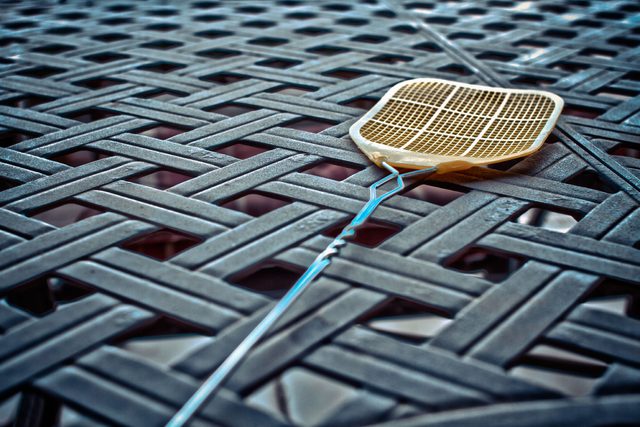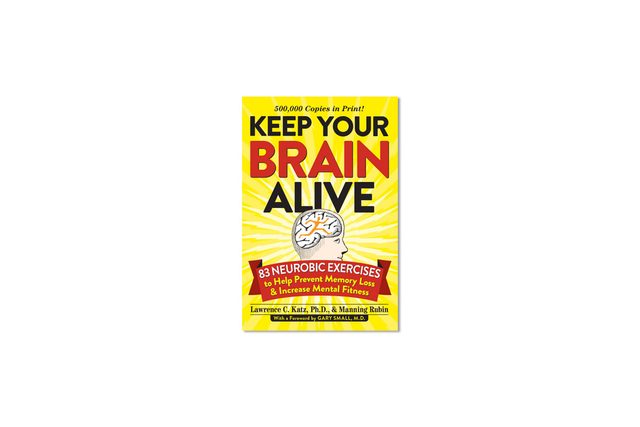
“Neurobic” exercises are like cross-training for your brain
Giving your brain new experiences that combine physical senses—vision, smell, touch, taste, and hearing—with emotional “sense” stimulates more connections between different brain areas, causes nerve cells to produce natural brain nutrients that dramatically help memory, and makes surrounding cells stronger and more resistant to the effects of aging. Try these brain exercises during your morning routine or your down time and see if you feel the difference.

Brush teeth with your non-dominant hand
Research has shown that using the opposite side of your brain (as in this exercise) can result in a rapid and substantial expansion of in the parts of the cortex that control and process tactile information from the hand. Brain exercise: Brush, and don’t forget to open the tube and apply toothpaste in reverse, too. Here are more morning brain boosters to do before work.

Shower with your eyes closed
Your hands will probably notice varied textures of your own body you don’t “see,” and will send messages back to your brain. Brain exercise: Try using just your tactile senses (although, use common sense to avoid burn or injury). Locate the taps solely by feel, and adjust the temperature. Then wash, shave, and so on with your eyes shut. Here are 9 more simple daily tasks that will sharpen your memory.

Switch around your morning activities
Brain imaging studies show that novel tasks exercise large areas of the cortex, indicating increased levels of brain activity in several distinct areas. This activity declines when the task becomes routine and automatic. Brain exercise: Get dressed after breakfast, walk the dog on a new route, or change your TV or news station. Even watching a kids’ program like Sesame Street, for example, may arouse the brain to notice how much of what you take for granted is explored in depth by children. Don’t miss these habits you never knew were aging your brain.

Turn familiar objects upside down (literally)
When you look at things right-side up, your left “verbal” brain quickly labels it and diverts your attention elsewhere. When they’re upside down, your right brain networks kick in, trying to interpret the shapes, colors, and relationships of a puzzling picture. Brain exercise: Turn pictures of your family, your desk clock, or an illustrated calendar upside down. Here’s what happens to your brain when you have sex.

Switch seats at the table
In most families, everyone has his or her “own” seat, but your brain benefits from new experiences. Brain exercise: Switch seats to change whose position you occupy, who you relate to, your view of the room, and even how you reach for salt and pepper. Serve some of these brain-boosting foods for an even smarter meal.

Make a new connection with your nose
You probably don’t remember when you “learned” to associate the smell of coffee with the start of a day. However, by linking a new odor—say, vanilla, citrus, or peppermint—to an activity, you’ll alert new neural pathways. Brain exercise: Keep an extract of your favorite scent near your bed for a week. Open it and inhale when you first wake up, and then again as you bathe and dress. Don’t miss these 22 other brain-boosting habits.

Open the car window
The hippocampus, an area of your brain that processes memories, is especially involved in associating odors, sounds, and sights to construct mental maps. Brain exercise: Try to identify new smells and sounds on your route. Opening the windows provides these circuits with more raw material.

Play with spare change
Because our brains regularly rely on visual cues to distinguish between objects, using touch to identify subtly different things increases activation in cortical areas that process tactile information and leads to stronger synapses. (Similarly, adults who lose their sight learn to distinguish Braille letters because their brain devotes more pathways to processing fine touch.) Brain exercise: Place a cup full of coins in your car’s drink holder. While at a stoplight, try to determine the denominations by feel alone. You can also put coins in your pocket, and identify them when you stop at a corner. Fun fact: These body parts could reveal how smart you are.

Play “10 Things”
Forcing your brain to think of alternates to the everyday will help keep it strong. Brain exercise: Someone hands you an ordinary object, and you must demonstrate 10 different “things” that the object might be. Example: A fly swatter might be a tennis racket, a golf club, a fan, a baton, a drumstick, a violin, a shovel, a microphone, a baseball bat, or a canoe paddle.

Scan at the supermarket
Stores are designed to have the most profitable items at eye level, and when you shop you don’t really see everything there. Brain exercise: Stop in any aisle and look at the shelves, top to bottom. If there’s something you’ve never seen before, pick it up, read the ingredients, and think about it. You don’t have to buy it to benefit; you’ve broken your routine and experienced something new. Check out these 10 signs you’re smarter than you realize.

Do an art project in a group
Art activates the nonverbal and emotional parts of the cerebral cortex. When you create art, you draw on parts of your brain interested in forms, colors, and textures, as well as thought processes very different from the logical, linear thinking that occupies most of your day. Brain exercise: Ask each person to draw something associated with a specific theme like a season, an emotion, or a current event.
This art activity has also been found to be a great stress-busting activity for adults.

Make more social connections during your day
Scientific research has repeatedly proved that social deprivation has severe negative effects on overall cognitive abilities. Brain exercise: Thirsty? Buy a drink from a person rather than a vending machine. Need gas? Pay the clerk at the counter rather than just swiping your credit card at the pump. Don’t miss these other ways work friends are good for you.

Read differently
When we read aloud or listen to reading, we use very different brain circuits than when we read silently to ourselves. Brain exercise: Read aloud with your partner or a friend, alternating roles of reader and listener. It may be slow to get through a book, but as a bonus you’ll spend quality time together.
Looking for a good book? Check out these new reads for summer.

Eat unfamiliar foods
Your olfactory system can distinguish millions of odors by activating unique combinations of receptors in your nose. There’s a direct link to the emotional center of your brain, so new odors may evoke unexpected feelings and associations. Brain exercise: Choose a cuisine unfamiliar to you, and browse the variety of novel vegetables, seasonings, and packaged goods.

Get More Brain Workouts
Keep Your Brain Alive, by neurobiologist Lawrence C. Katz, PhD, and Manning Rubin, is packed with 83 neurobic exercises to increase mental fitness and help prevent memory loss. Next, discover 10 crucial health tweaks you need to make by your 50s.
